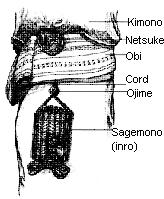|
What
is a netsuke?
Today,
the most commonly known sagemono is the "inro" which is a
elaborately decorated, multi-compartment case used to hold snuff. Most
modern inro are carved out of wood or bone with scrimshaw work as shown
in my online inro samples albums. Ojime
is the name of the sliding button device that resembles a bead. It is
usually 3/4 inch in diameter or less and can be made of any material. It
is sometimes a unique carved animal or just plain. One distinct
difference between an ojime and a bead is the center hole of the ojime
has to be larger to accommodate the double thickness of the cords that
secure the compartment. As for the netsuke (pronounced "nets-kay".
The word comes from the Japanese word for "root" or
"twig". History dictates that the original netsuke were carved
from a piece of root or small piece of branch. Artists over the years
have made the designs more and more elaborate thus developing it into a
cherished art form. Today,
contemporary netsuke of the finest quality are still being carved, as
highly respected, original works of art. While not intended to be worn
they adhere to all the standards of a true netsuke. There are several
dozen highly successful netsuke artists, many of whom have been
apprentices to great carvers of the past, who are currently creating
modern masterpieces. Another fascinating aspect of these contemporary
netsuke is that they reflect the time and place in which artists live.
In the early part of this century, dealers encouraged netsuke carvers to
emulate antique netsuke both in style and subject matter. These had a
charm of their own. Now,
contemporary netsuke artists are exploring new techniques, new subject
matter and new materials. This vibrant approach to netsuke has captured
the interest of both old and new collectors throughout the world. Also,
netsuke carving is no longer confined to the Japanese. In |
 Netsuke(nets'keh)
is a small carving usually of wood or ivory serving as a toggle
Netsuke(nets'keh)
is a small carving usually of wood or ivory serving as a toggle